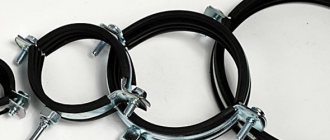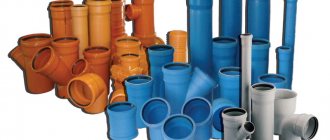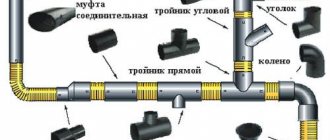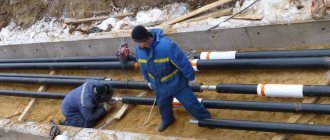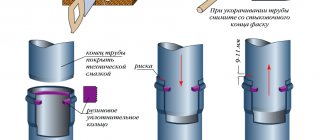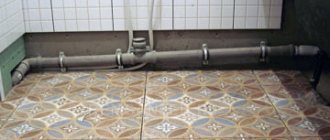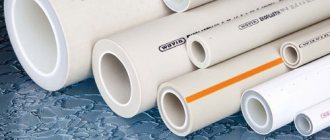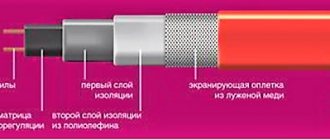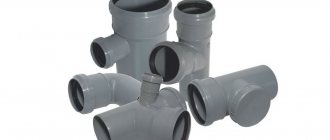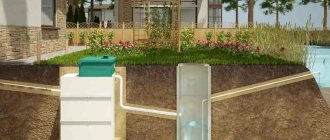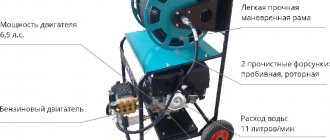Design and construction
If you plan to build a sewer well on your own plot of land, and you are going to do it yourself, you need to know what stages of work lie ahead of you.
The first step is to determine the type of well: storage or drainage.
Depending on this, you will need to create a project.
It should include the dimensions of the structure, a list of structural elements, as well as data on the location of the well on the site.
The latter are regulated by SNiP norms and SES provisions, and therefore must be complied with.
Sewer well, diagram according to SNiP
The project, after completion, must be approved by the SES; only after receiving a construction permit can installation begin.
Design of a sewer well according to SNiP
When designing a structure, it is important not only to comply with all the exact characteristics, but also to correctly determine the appropriate material from which the well will be made.
Today, it can be built from a variety of materials, even from tires or old barrels.
But the most popular, due to their practicality and durability, are structures made from the following materials:
- moisture-resistant brick - such wells will last for several decades. But the device is complicated by the fact that increased attention should be paid to tightness. In addition, the cost of bricks is quite high, which calls into question the benefits of such construction;
Moisture resistant brick
- reinforced concrete rings - they have increased strength and are available in a large selection of sizes. The cost of the products is quite low. But, in this case, you will have to hire special equipment, because the weight of concrete products is impressive;
Reinforced concrete rings
- plastic containers - they are light in weight, easy to install, and have high leak-tightness. You can choose any required product model. But, the price of the issue is higher than in the previous version.
Plastic container
Considering the fact that most often preference is given to concrete rings, we will consider the installation sequence using their example.
The construction of sewer wells of this type can be done with your own hands:
Installation of a well made of reinforced concrete rings
- dig a pit of appropriate volume. It must be larger than the volume of the well itself;
- compact the soil at the bottom of the pit;
- make a sand cushion 20 cm high;
- arrange the bottom. You can fill it with cement, or you can lay a finished concrete slab;
- lower the first concrete ring into the pit;
- seal its joint with the bottom using cement mortar and bitumen mastic;
- connect a sewer pipe to the previously made hole in the ring, coat the joint with bitumen to make it airtight;
- lower the second concrete ring, treat the seam with cement mortar and waterproofing;
- install a concrete floor, on which the hatch will subsequently be mounted.
Well made of reinforced concrete rings installed
If a drainage well is planned, then instead of a sealed bottom there will be a layer of medium-fraction crushed stone. Its height will be approximately 40-50 cm.
Principle of operation
Having found out what a sewer collector is, let’s consider the principle of its operation. Wastewater from plumbing fixtures enters horizontal yard networks. They are connected into quarters and eventually join the main highway. It transports wastewater to treatment facilities. Thus, the sewer collector is a common pipeline that connects all the small lines together. It itself never branches into parts.
In autonomous systems of private houses, the role of the main element of the sewer system is played by a horizontal pipe connecting the system exit from the house with the receiving section of the septic tank. Its length is usually short, but the function it performs is no different from the tasks of large sewer pipelines.
In addition, there are storm drainage systems. They differ from household or industrial networks in their seasonal operating mode and relatively shallow depth of immersion in the ground. A storm sewer is a channel that carries rainwater to treatment systems. It can be implemented in the form of an underground pipe or in the form of an open gutter.
There are two types of channels, differing in the way wastewater moves:
- gravity type. Pipeline installed with a slight slope. Waste liquids move through it independently, under the influence of gravity;
- pressure sewer collector. Designed for forced supply of wastewater from a lower level to a higher level.
Gravity lines prevail because they are more profitable and simpler. However, sometimes it is necessary to use a pressure type sewer system if the terrain requires it, or if there are buildings, structures, or highways in the way of pipe laying.
A sewerage pressure manifold is a sealed pipeline designed for a certain fluid pressure. The wastewater is moved through it using a special pump. To reduce loads and save energy, the pressure sections of the collectors are made small. Typically, a sewage pressure station (SPS) is installed, which supplies wastewater under pressure to a certain height. The liquid then follows by gravity.
The lifting of wastewater can occur either downhill or using a vertical pipeline. The choice of a suitable method is made based on local conditions - topography, presence of structures or buildings, soil characteristics.
Also read: Sewer pipe socket: what is it, features, installation
SNiP requirements
The main requirements of SNiP include the following:
Scheme of wells made of concrete rings according to SNiP
- the well must be sealed. The presence of a drainage layer instead of a bottom is possible only with a daily waste volume of up to 1 m3;
- the well must be located on the site, taking into account the minimum distance to all its objects specified in the same document;
- the well must be equipped with a lid to prevent the spread of odors throughout the area and the entry of debris into the structure;
- the depth of the well cannot exceed 3 meters.
Sewage well location diagram
As for the location of the sewer well in relation to other structures located on the site, it should be like this:
- at least 5 meters from a residential building;
- more than 1 meter from outbuildings;
- at least 2 meters from the neighbor’s fence;
- 30 meters from a well or well with drinking water;
- 3 meters from the road.
If these parameters are not met, the project will not be approved by the SES.
What does a drainage system project include?
The project is a package of technical documentation with a complete description, engineering calculations and installation recommendations. It also includes:
- estimate and specification indicating recommended units, materials and devices;
- data on the economic efficiency of the system, its safety and reliability;
- detailed layout of pipes, units, pumps, and other elements.
The documentation developed during the design of the sewer system becomes a “road map” for the installation specialists. Accordingly, the operational characteristics of communications directly depend on the correctness of the design.
If you need a flawlessly functioning, reliable and durable sewerage system, order its design from!
free consultation with a specialist
How to calculate volume
One of the main indicators is the volume of the sewer well.
It must be calculated so that no problems arise during the operation of the structure, for example, too rapid filling.
Calculation of the volume of a sewer well made of rings
If we talk about a storage well, then the volume is calculated using a very simple formula: V=n*q*15, where:
- V – volume of the sewer well;
- n – number of people permanently residing in the house;
- q – volume of water in liters. Per day per person;
- 15 – service interval for the sewage disposal machine, in days.
For example, you need to calculate the volume of a well for a family of 3 people. Then we get the following: 3*200*15=9000 liters or 9 m3.
Septic tank made of reinforced concrete rings for 9 cubic meters
If we talk about the volume of a drainage well or septic tank, then instead of 15 in the formula you need to put the number 3. This is how long the wastewater coming from the sewer system is processed through the natural processes of rotting and fermentation.
Hydraulic incline and self-cleaning speed
The hydraulic slope of sewer pipes allows for high-quality passage of the contents of the sewer system. If this value is calculated correctly, then the likelihood of pipeline clogging is minimal. This factor is important for the smooth operation of the entire system.
Sewage system diagram.
The calculation of the hydraulic slope depends on such indicators as the diameter of the sewer pipe and the self-cleaning speed. This calculation is suitable primarily for domestic sewerage pipelines, since they have some features related to the viscosity and physical state of the contents passing through them.
Self-cleaning speed is the speed that is the maximum for the flow of sewer contents, which is determined at the maximum design flow. At the same time, the pipes must be free of blockages, dirt and silt deposits.
The magnitude of the self-cleaning speed depends on the diameter of the pipes. The correspondence can be clearly shown in the following table:
| Pipeline diameter, mm | Self-cleaning speed |
| 150-250 | 0,7 |
| 300-400 | 0,8 |
| 450-500 | 0,9 |
| 600-800 | 1 |
The same correspondence can be seen between the values of the hydraulic slope and the diameter of the pipes:
| Pipeline diameter, mm | Hydraulic slope |
| 150 | 0,0086 |
| 200 | 0,007 |
| 150 (unfavorable terrain) | 0,007 |
| 200 (unfavorable terrain) | 0,005 |
As for pipes with a diameter exceeding 200 mm, the slope is calculated based only on the self-cleaning speed in the pipeline.
The cost of designing a sewerage structure in Moscow
Today, old cast iron pipes are being successfully replaced with pipelines made of polymer materials. The introduction of modern technologies and innovative materials in the drainage system can significantly simplify installation work and save budget. At the same time, polymers have all the properties necessary for operation, have high technical performance, a long service life, and fewer disadvantages in comparison with traditional materials.
To create a high-quality sewer system project, it is necessary to take into account many points and details. Therefore, the design cost is formed individually and calculated based on the following factors:
- type and scale of the object;
- type of drainage;
- complexity of development;
- number of plumbing points;
- difficulties in coordinating documentation;
- selection of materials and equipment.
Features of the system in private households
In accordance with SNiP and GOST, the installation of sewer wells in the area adjacent to a private house is impossible without the construction of inspection collectors. Such a structure is necessary to control the movement of sewage through the pipeline system and clean the pipes if necessary. This procedure, in accordance with the requirements of SNiP sewer wells, is carried out quarterly.
It is mandatory to install inspection manifolds, the distance between which depends on the length of the pipeline and the diameter of the installed pipes:
Sewerage diagram in a private house
- With a pipe diameter of 15 cm, each subsequent collector should be located at a distance of 30 to 40 meters from the previous one.
- If the system is installed using pipes with a diameter of 20 cm, then the distance to the collector will be at least 50 m.
According to the requirements of SNiP and GOST, the installation of inspection wells must be carried out at pipeline turns, at pipe junctions and where branches from the main pipe are created.
Construction of sewer wells in accordance with SNiP and GOST is possible by selecting the appropriate components. Since collections can be made not only of stone, but also of plastic, it is necessary to be very careful when choosing and purchasing components.
Calculation features
Main types of sewer well structures
In accordance with existing standards and requirements of SNiP and GOST, the constituent elements, without which high-quality installation of sewer wells is impossible, can be reinforced concrete and polymer. The choice depends on the characteristics of the collector itself, and the basic requirements are described in the accompanying instructions.
The installation of sewer wells will take place as quickly and efficiently as possible, in strict accordance with GOST and SNiP, if the installation specialists pay attention to the permitted options for combining structural elements and are able to comply with all the dimensions specified in the documentation.
The volume that the inspection and sewer well will have can be calculated by knowing its depth and diameter, and these parameters must strictly comply with SNiP:
- 15 cm with a pipe diameter of 0.7 cm;
- 1 m – 60 cm;
- 1.5 m – 150 cm;
- more than 1.5 m with a pipe diameter and well depth of more than 3 m.
The construction of sewer wells begins with excavation work. They include site preparation, marking, and digging a pit.
Main stages of designing sewerage networks
To create a project and then install a drainage system, specialists need to perform a number of operations. For example, to determine the characteristics of the soil, it is necessary to conduct engineering-geological studies. They also carefully study the architectural features of the structure and determine the throughput of city utility networks.
To create a project, specialists find out the following information:
- Method of supplying water to the object.
- Wastewater disposal method.
- The location of the building relative to other objects, its features and purpose.
- Determining the location of the riser.
- Number of plumbing connection points at the site.
- Load on the soil and depth of its freezing.
- Availability of groundwater, etc.
The design itself consists of such stages.
- Data collection.
- Creation of technical specifications based on the received data and taking into account established regulatory requirements.
- Drawing up a project.
- Coordination of the project document with supervisory authorities.
- Creation of working documentation.
Materials used for installation of external sewer networks
In addition to all the above factors, a very important point is the selection of the necessary materials for arranging the sewer network and water supply network. Wastewater is a medium that is transported through sewer pipes. Such a working environment is characterized by aggressive properties, therefore, for arranging communications, it is necessary to select materials that have the appropriate characteristics for working in such conditions.
When laying external networks, modern polymer pipes are often used
Let's consider the main materials that are used for the installation of external water supply and sewerage networks:
- polyvinyl chloride (PVC);
- polypropylene (PP);
- polyethylene (PE);
- steel;
- cast iron;
Today, metal sewer pipes are being actively replaced from the construction market by polymer parts. For external installation, the plastic version of the water supply system is especially popular. This is due to the fact that external installation of metal pipes is much more labor intensive.
Polyethylene pipes are also quite popular when installing sewer systems, however, open laying of such pipes is not the best option. This is due to the fact that they have poor resistance to ultraviolet rays. On the street, they quickly lose their properties and are destroyed, so their outdoor installation is allowed only if a protective casing is used. This could be an old steel pipeline.
The most profitable and reliable option of all is the use of polyvinyl chloride pipes. They are characterized by low cost, good strength properties, and resistance to ultraviolet radiation. Their installation is faster than wiring metal analogues. PVC pipes for external sewerage differ in diameter and length, and also have different wall thicknesses. The diameter and length of PVC pipes for external sewerage are presented in Table No. 1.
Table 1
| Du, mm | Length, m |
| 500 | 3,0–6,16 |
| 400 | 1,2–6,15 |
| 315 | 1,2–6,14 |
| 250 | 1,2–6,13 |
| 200 | 1,2–6,09 |
| 160 | 0,58–6,08 |
Sewage pipes made of polyvinyl chloride are used for the construction of internal and external sewer networks and structures.
PVC pipe can be:
- pressure;
- non-pressure.
The surface of such pipes, as a rule, is smooth, however, corrugated sewer pipes made of polyvinyl chloride are also found.
Free-flow PVC pipes can only be installed in a gravity-type system
Non-pressure pipes made of polyvinyl chloride are used for the installation of external sewer lines that transport liquid at a certain slope. The speed of movement of the working medium in such pipelines does not exceed 8 m/s. Pressure pipes are used to install structures that drain wastewater using pumps. The pressure in a pressure sewer made of polyvinyl chloride, installed externally, can reach 10 atmospheres or more.
Corrugated pipes made of polyvinyl chloride have the main advantage that they can be installed in problem areas. In addition, you do not need special equipment to install them. Corrugated PVC pipes are used in both pressure and non-pressure communications. The dependence of the wall thickness of the PVC pipe on the diameter is indicated in Table No. 2.
table 2
| Du, mm | Wall thickness, mm | ||
| Lungs (SN2) | Medium (SN4) | Heavy (SN8) | |
| 500 | 9,8 | 12,3 | 15,3 |
| 400 | 7,7 | 9,8 | 12,3 |
| 315 | 6,2 | 7,7 | 9,7 |
| 250 | 4,9 | 6,2 | 7,7 |
| 200 | 3,9 | 4,9 | 6,2 |
| 160 | 3,2 | 4,0 | 4,9 |
| 110 | – | 2,7 | 3,4 |
In some cases, materials such as reinforced concrete and asbestos cement are used. They are used when it is necessary to organize pipes with a very large diameter. Such materials are not highly durable, so they are used to install non-pressure sewers that drain wastewater naturally.
Information indicated at the top and bottom of the longitudinal profile
The space that is at the top and bottom of the longitudinal profile is filled with information, which includes various calculations and design data required to create a sewer system. All hydraulic calculation data are applied to the longitudinal profile (top and bottom).
Storm drainage scheme.
At the top of the longitudinal profile are all structures that are located away from the ground. This applies to overpass bridges, pumping stations, buildings and other things. Information such as the depth of pipes is also noted there. Don’t forget about the drill hole numbers; they are also marked at the top of the longitudinal profile.
The space located at the bottom of the profile is intended for calculation and other information. Information on all the hydraulic calculation data of the sewer system is entered there. Additional plans and diagrams that are needed to create a sewer system are also inserted there.
At the bottom of the longitudinal profile of the sewer system, all numerical data is located, for example, the length of the entire pipeline, the distance of individual sections, the height of wells, etc. The laying depth is also noted there, along with the slope angles of the sewer pipes.

